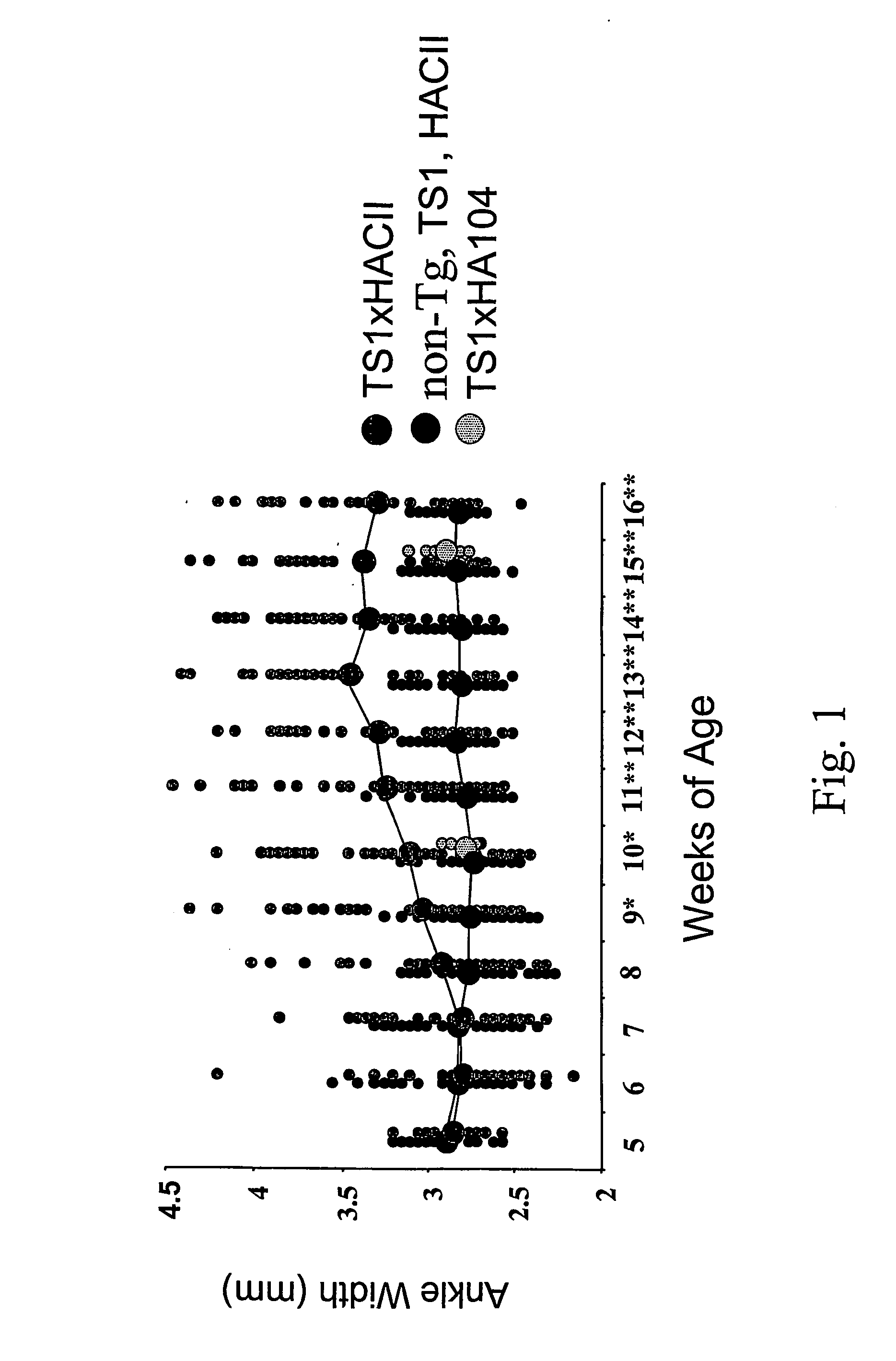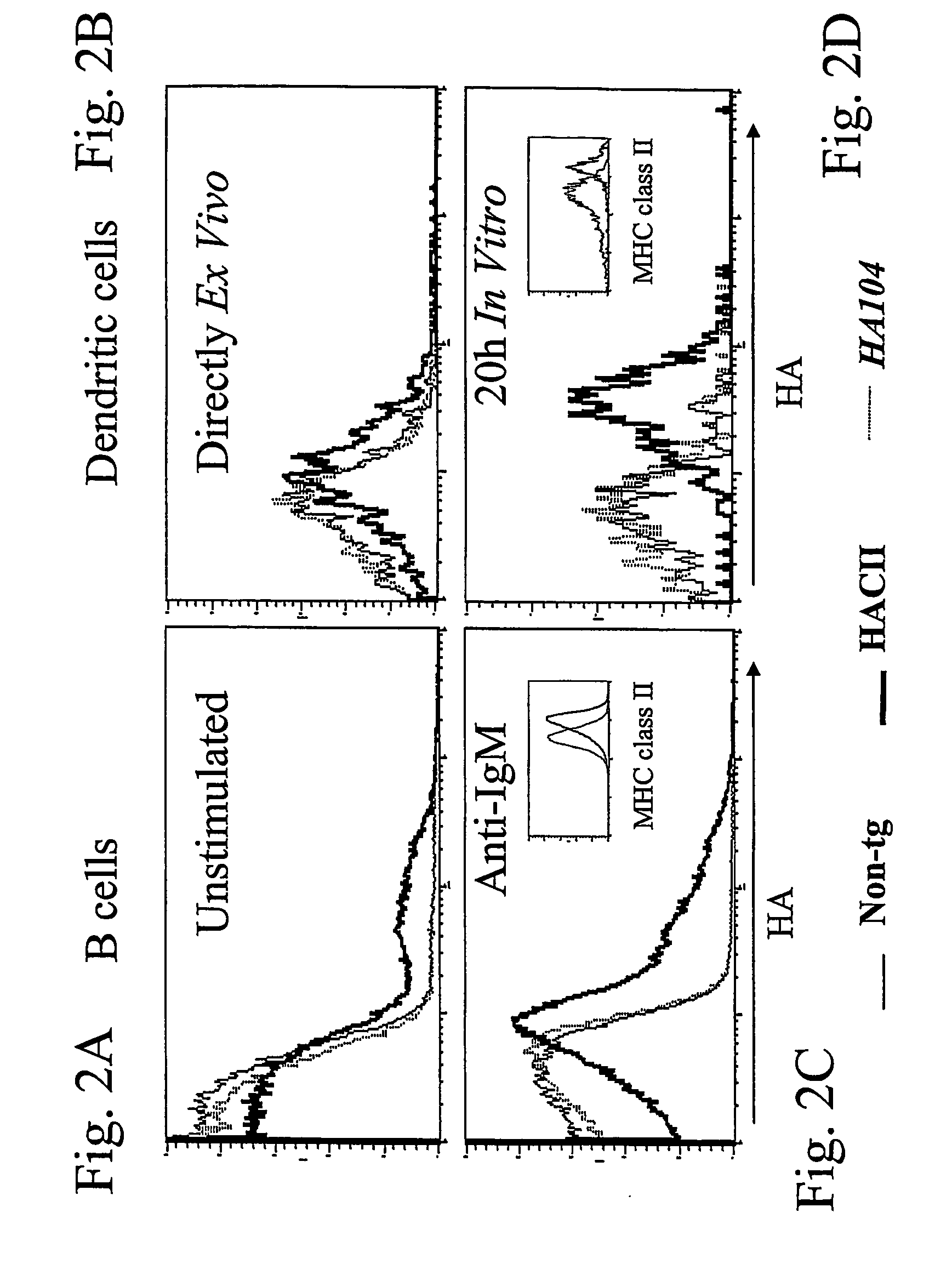Mouse model for autoimmune disorders
a mouse model and autoimmune disease technology, applied in the field of mouse model for autoimmune disorders, can solve the problems of poorly defined pathologic effector functions, processes by which autoreactive cd4+ t cells become activated, and promote the elaboration of pathologic effector functions, etc., to achieve low genotypic penetrance, high likelihood of development, and high genotypic penetrance
- Summary
- Abstract
- Description
- Claims
- Application Information
AI Technical Summary
Benefits of technology
Problems solved by technology
Method used
Image
Examples
example 1
Transgenic Mammalian Models
[0109] A. Models Expressing an Influenza HA Polypeptide
[0110] Transgenic HA104 mice contain DNA encoding the full-length, membrane-bound polypeptide of the influenza virus A / PR / 8 / 34 HA linked to the SV40 early region promoter / enhancer sequences (F. F. Shih et al, 1997 Int. Immunol., 9:249; M. P. Riley et al, 2000 J Immunol., 165:4870-4876). This transgenic mouse lineage expresses transgene mRNA in the thymus and in peripheral lymphoid tissues at high levels. This transgenic lineage generates reduced T cell proliferative responses relative to BALB / c mice, to the major I-Ed-restricted T cell determinant from the HA, termed S1. Transgene mRNA expression in tissues from HA104 mice was determined by RT-PCR analysis (Shih et al, 1997, cited above). These mice express HA diffusely, but do not synthesize the HA by their APCs.
[0111] Transgenic HA28 mice contain DNA encoding a truncated polypeptide of the influenza virus A / PR / 8 / 34 HA linked to the SV40 early regi...
example 2
Assay Methods
[0117] The following Examples 3-6 employ and discuss the results of the application of a number of the following procedures and protocols, which are assembled and discussed herein for ease of reference.
[0118] A. Flow Cytometry Procedures
[0119] Flow cytometry was performed on single cell suspensions isolated from the bone marrow, thymus or spleen of 10- to 16-week-old mice. For isolation of dendritic cells (DCs), spleens were injected with 2.5 ml of collagenase (6 mg / ml; Gibco-BRL) and DNAse I (0.3 mg / ml; Roche Molecular Biochemicals) in supplemented IMDM, teased apart and incubated for 1 hour at 37° C. A single cell suspension was prepared by passage through an 18.5G needle and cells were washed into supplemented IMDM with 10% fetal bovine serum (FBS).
[0120] Cells were first incubated with unlabeled anti-CD16 / CD32 (2.4G2) to block Fc□ receptors and then stained with labeled antibodies. Antibodies used were: anti-1-Ad-FITC (AMS-32.1), anti-CD45R / B220-PE (RA3-6B2), an...
example 3
The Development of Inflammatory Arthritis Resembling Rheumatoid Arthritis in TS1xHACII Mice
[0135] To examine how self-antigens expressed by MHC class II+ cells mediate negative selection of autoreactive CD4+ T cells, a new mouse model was generated for inflammatory arthritis (TS1xHACII mice). The transgenic mouse lineage (HACII) expressing the HA antigen under the control of an MHC class II promoter was mated with the mouse lineage (TS1), expressing a transgenic TCR specific for the major I-Ed-restricted determinant of HA (S1). Both lineages are described in Example 1A. Thus, TS1xHACII mice co-express the influenza virus PR8 hemagglutinin (HA) under control of a MHC class II promoter and a HA-specific MHC class II-restricted TCR. Unexpectedly, an unusual phenotype emerged. A substantial fraction of the TS1xHACII mice develop swollen joints and an inflammatory process in the lungs that are characteristic of human rheumatoid arthritis. Specifically, the symptoms shared with RA includ...
PUM
| Property | Measurement | Unit |
|---|---|---|
| thicknesses | aaaaa | aaaaa |
| width | aaaaa | aaaaa |
| affinity | aaaaa | aaaaa |
Abstract
Description
Claims
Application Information
 Login to View More
Login to View More - R&D
- Intellectual Property
- Life Sciences
- Materials
- Tech Scout
- Unparalleled Data Quality
- Higher Quality Content
- 60% Fewer Hallucinations
Browse by: Latest US Patents, China's latest patents, Technical Efficacy Thesaurus, Application Domain, Technology Topic, Popular Technical Reports.
© 2025 PatSnap. All rights reserved.Legal|Privacy policy|Modern Slavery Act Transparency Statement|Sitemap|About US| Contact US: help@patsnap.com



